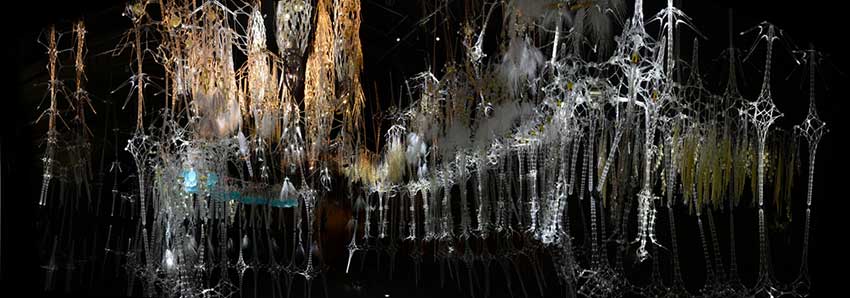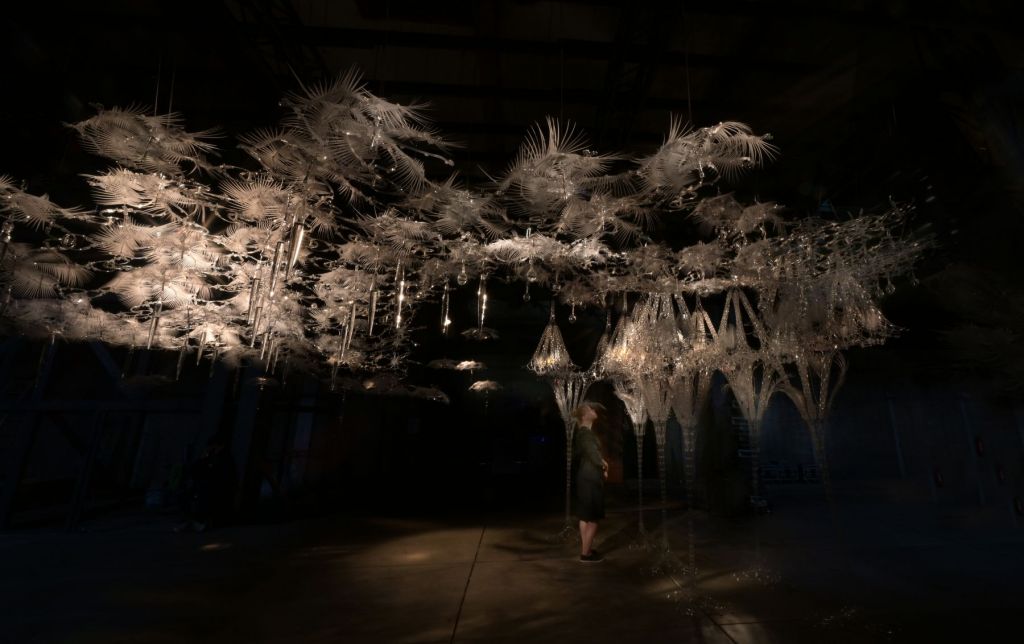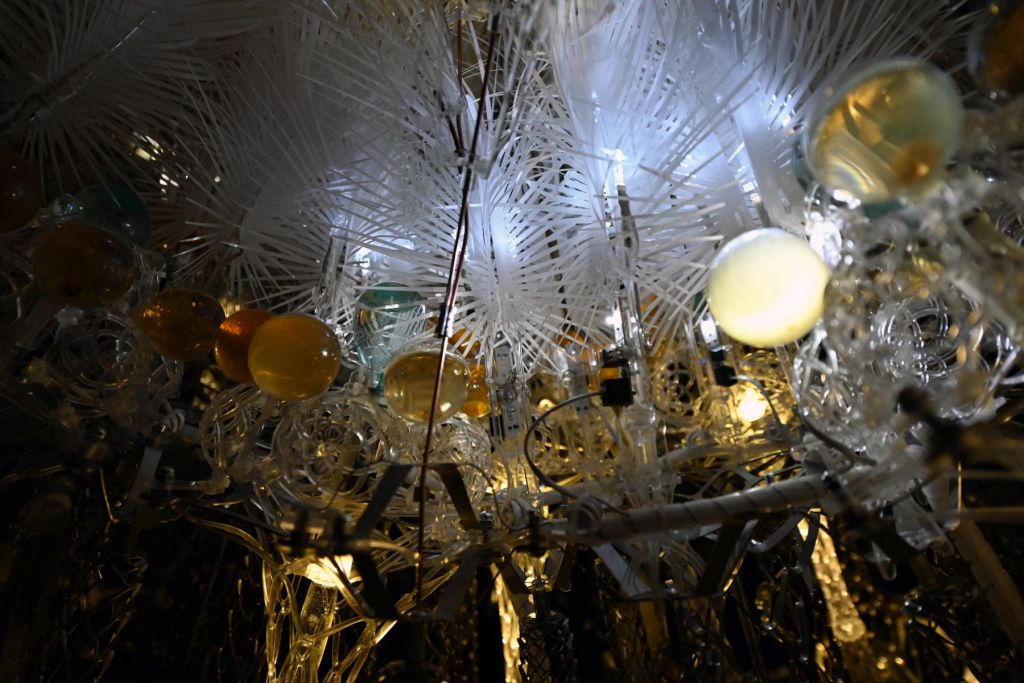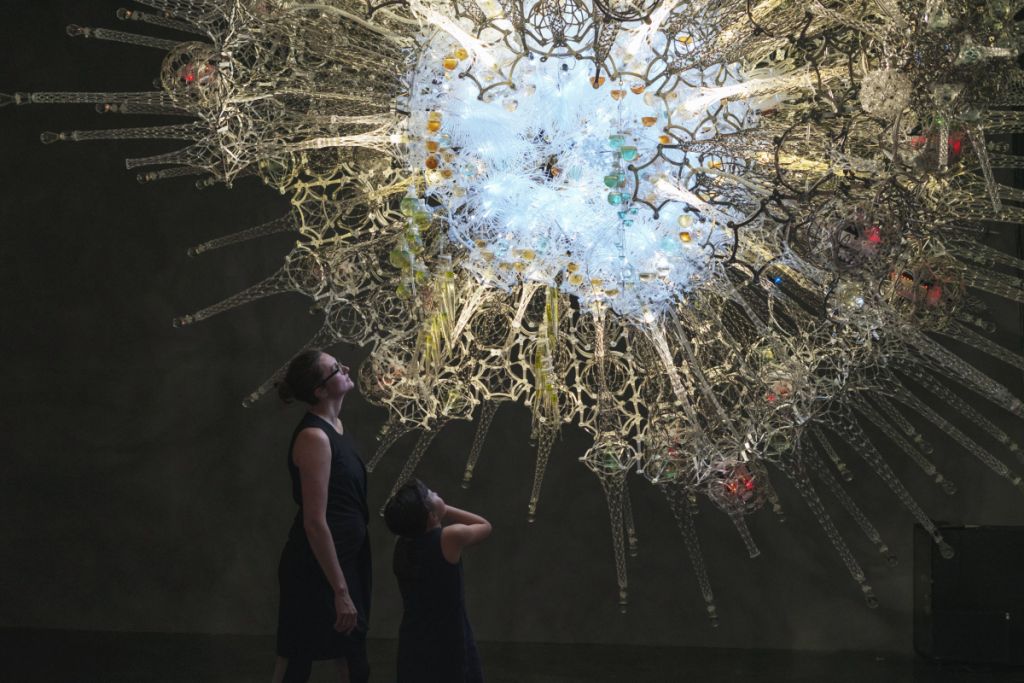Interview Lidia Ratoi

From the Buddhist concept of completeness in Nirvana to James Hilton’s Shangri La, a utopian place of perfection, to the biblical depiction of heaven, to Dante’s aethereal and so on, man has always strived to find the sublime beauty. Philip Beesley describes himself as a sculptor who is dedicated to building prototypes for the future. But I would say he is one of the last dreamers and a maker of sublime worlds – worlds that are right here, on earth, accessible to anyone.
Beesley is an architect, installation artist, designer, sculptor, and leader of leading the Scaffold discipline stream within the Living Architecture Systems Group, which brings together researchers and industry partners in a multidisciplinary research cluster dedicated to developing built environments with qualities that come close to life. His stories are as intricate and interesting as his work, and a glimpse into his thoughts is like walking through a fantastic universe.
Growing up with post-World War 2 machinic-nostalgia, Beesley started experimenting with technology at a young age. Familiarising himself with it allowed him to be able to master it throughout his adult life and go beyond the first stage of technological research. His works, though pushing the boundaries of tech, are not displays of machinic power but beautiful, sensitive and noble creations which bridge the gap between humans and their own creation – that of mechanical tools.
Considering that nature is paired with technology, he seamlessly transitions from one branch of work to another, blurring the boundaries between those. Some of his works have a life of their own – such as Amatria, which has as a core the emergence of life during the earliest stages of development of the universe. However, other works have life in relation to their environment. Futurium Noosphere, done in collaboration with the Living Architecture Systems Group, consists of minimal-weight thin sheets of metal and polymer stretched into optimal ‘hyperbolic’ meshworks. Interwoven microprocessors create a system which can recognise viewers and experiment with new types of behaviour. Additionally, fields of small speakers and microphones immerse the visitor with expressive sound.
Beesley treats not only creation but also technology as an endearing element with its own identity, behaviour and mission – such an example is Sentient Chamber, a free-standing pavilion that combines three new systems of structure, electronics and software controls. Designed as a testbed for ongoing research that combines the disciplines of architecture and visual art, computer science and engineering, and synthetic biology, the sentient element mixes with human sensibility and creates not a space but an experience.
Be it Breathing Columns, such as in Hylozoic Grove, or wearable pieces of technology, such as Between the Lines, done in collaboration with Iris van Herpen; it is visible throughout the work of Philip Beesley that his meta-worlds are what dreams are made of – be it machinic dreams, digital dreams, of man-made dreams. However, isn’t it nice when dreams can come to life?



You are an architect, designer, investigator, artist, and an emblematic presence in the digital community. But for our readers who are less familiar with your work, how would you categorise it?
I think of myself first as a sculptor who is dedicated to building prototypes for the future. The sculptures I make have a wide range of dimensions, from intimate clothing to immersive landscapes. For the last several years, several different technologies–careful ‘making’ of forms using old and new crafts, interwoven light, sound and motion, all controlled by strong interactive systems and liquid chemistries- have gathered within hovering reef-like field structures.
My work searches for answers to the question of how we can live within the myriad interwoven realms of the natural world and how we can live together as a human species. Instead of the rigidly bounded territories that divide us, could we live in fragile, open, hovering worlds? Instead of valuing resistance and closure, I think new form-languages for architecture, sculpture and couture alike could foster mutual relationships and maximum interaction. These interwoven hybrid structures can convulse and stutter in emerging vitality, seeking intense mutual relationships of exchange with surrounding environments.
Architecture and interior design, due to the large scale, the presence of a direct beneficiary, the utilitarian and financial component, remained even throughout the 21st century rather modernist in approach. You have been one of the first architects to shift towards the digital and truly embed contemporary technology into design. How did your interest in such an approach emerge?
Perhaps utility and finances are indeed a restraint for architecture and interior design. However, the world itself surges forward. My interest in contemporary technology first came from my childhood. I think of my own parents as beautiful people who kept exploring throughout their whole lives, curious about emerging technologies and also about turbulent social structures after the traumas they witnessed in Europe during the Second World War. They brought a curiosity about contemporary technology to me in my childhood, bringing home buzzing wires, bubbling synthetic chemistry, strangely fascinating graphics and psychology experiments in books, and experiment into my home throughout the years of my childhood and awakening adolescence. I think the hybrid qualities given by my parents encouraged learning about experimental, alien technology alongside deeply personal and emotional play.
It seemed only natural to play with digital punch-cards controlling relays and transistors as a teen, and likewise with pen-plotters and hard drives in my early twenties. One of the qualities that might have influenced me in this constant playful search has been a sense of tangible, physical touch. My father was involved in the invention of microwaves as a young apprentice right after the war, and he spoke rather happily of how his hands tingled as he warmed his lunch on the open coils of first-generation microwave ovens. I think I’ve inherited some of his curiosity and physical involvement.
In previous works, such as Aurora or Sargasso, the focus was on light and movement under the aegis of a certain PB aesthetic quality. However, the latest works, such as Futurium Noosphere and Sentient Veil, introduce the sound component. Is this constant addition of factors a matter of life imitating art (or, better said, machines imitating humans), or of the evolution of technology?
The vision of multiple dimensions all converging together evokes a kind of eternal quest for human civilization. Me, I think this comes from all three of the options you’ve offered: life imitating art, machines imitating humans, and the evolution of technology.
The coupling of nature with technology is, of course, fundamental in human culture, and so that suggests some kinds of convergence are inevitable. Alongside that, the serendipity of wonderfully generous collaborators has helped encourage integration within my own work. Sound, light and motion have tended to oscillate in development during decades of my work, starting with experimental theatre encouraged by inspired teachers during my teens.
Some early workshops deliberately attempted to integrate alien and synthetic dimensions, treating those as kinds of delicious feasts of new sensation to be freely explored. Some of that came from exchanges with artists who became close friends during extended collaboration, such as Warren Seelig, an extraordinary US textile artist; the British doctor-philosopher Rachel Armstrong; sound artist-architect Jonathan Tyrrell; engineer Rob Gorbet; beloved experimental couture designer Iris van Herpen and her sound composer-partner Salvador Breed.
Perhaps some parts of hybrid synthesis come from sheer friendship and people from alien fields working to understand each other, naturally creating convergence and shared language within each other’s work. However, part of this undoubtedly comes from the evolution of technology itself. It is now possible to know, with exquisite precision, many of the impacts that our buildings have on our environments. The Genome and Connectome projects and the new physical dimensions unlocked by Geneva’s CERN facility are only a tiny fraction of surging knowledge today. That progress contains an extraordinary sense of continuity within our physical world, making it increasingly possible to cross from scale to scale and making it possible to touch, however hesitantly, strange and alien dimensions.
Mentioning this idea of aesthetics, it is noticeable that while your works are each unique, they do carry a similar formal philosophy. How does your practice view the idea of form? Is it a consequence of functionality, of technology, an entire idea on its own or a cumulation of these?
Yes, some qualities within my work have tended to last over many years and in multiple generations of work. Some specialized languages have been built up that seem to continually offer new variation and refinement, motivating many generations of cycles and encouraging gradual evolution. These have crystallized into quite resolved form-languages that now tend to recur within projects, undergoing minute refinements. Because individual elements tend to be massively duplicated within these environments, very small inflexions can make huge differences in the emergent qualities that result.
Form, for me, has profound consequences. In spite of extraordinary flexibility and precarious flowing gestures being readily available, I think I only rarely see specific forms as free or arbitrary. Instead, I tend to see them as ‘diagrams of forces’, following paths of energy-transfer and chains of reactions along multiple vectors. When measured for their impacts in particular environments, specific forms can also have terrible consequences, and on the other hand, their influence can be deliciously refreshing and gentle. I’ve tended to view closed, clearly, bounded forms with suspicion, judging them for their capacity to be violent and to exclude and constrict. Yet, of course, that polarized attitude needs to be taken with discretion because, amidst anoxic swamps and saturated fields, the cutting swath of a closed-form can create openings and clarity.
You are leading the Scaffold discipline stream within the Living Architecture Systems Group. The group is developing built environments that can move, respond, and learn, with metabolisms that can exchange and renew their environments, adapting towards their inhabitants. How do you view this relationship between the contemporary man and all the other 21st century presences, such as AI, robotics, responsive systems etc.?
Let me give a slightly longer answer to clarify just why the scaffolds we’re making look the way they do. Our climate catastrophe suggests that the boundaries of nature are being fundamentally violated by human technology, threatening the integrity of our home planet. Yet at the same time, we know that life thrives precisely at the edge of alien realms and that our bodies are capable of integrating all manner of synthetic dimensions.
I find myself repeatedly turning to the philosopher and critic Donna Haraway, who famously said that she did not need to police the boundaries between nature and technology; rather, she relished the traffic, creating a powerful infidel glossolalia. That sheer fertility is part of our reality, along with the strains and erosion of life that we also see all around us. I think the sensitive confidence she offers is essential for us to create positive change. And yet the catastrophe seems unspeakable in its gravity. It is this kind of intertwining of ‘gravitas’ with curiosity and inventive searching that underlies our work in the new Living Architecture Systems Group.
I believe that we can make strong contributions to the world by inventing hybrids and resilient scaffolds capable of handling all kinds of turbulent forces. Instead of valuing resistance and closure, new architecture can foster mutual relationships and pluripotent interaction. My work tends to be opposite to the stable enclosing walls of the city. Those might provide resistance and hardened boundaries that provide local sanctuaries, but those same walls create turbulent disjunctions, and I think that while they can solve temporary problems- imbalance from immigration, insecurity from strife, natural forces far from equilibrium- they can also make things a lot worse.
After all, we know how flood-walls on rivers work, greatly compounding the forces of floods and stripping and sweeping away everything left within river channels. Instead of closed boundaries, I think an alternative architecture can construct dynamic, constantly shifting open thresholds that invite constantly renewed exchange. Those kinds of structures might look like wetlands and swamps, deeply intertwined. Far from weakness and vulnerability, this kind of exchange can directly support thriving living systems.
The inclusion of active systems like expanded-controls and distributed robotics is directly related to this. I love the idea that instead of making closed, opaque walls, we might be able to create architecture that opens itself in porous exchanges, constantly cycling and renewing itself.
While we have been witnessing interactive installations for the past decade, Futurium Noosphere seems to be more of a meta-world that an art piece. It comprises sounds, light, and motion, paired with human actions, from individualistic to swarm behaviour. What was the initial thought process, and how did it divagate into the complex piece that it is?
The thought process around Futurium Noosphere has cascaded through several layers. Perhaps a first layer is thinking of inorganic and organic life alike as making up one comprehensive living being. I love the Russian biologist Vernadsky’s conception, early this past century, which saw the whole earth as one ‘biosphere’ organism.
The mid-twentieth century geologist and theologian Teilhard de Chardin offers an even more provocative vision where increments of sentience shared between all sentient beings within the planet create one comprehensive consciousness, a ‘noosphere’. Now, my own work tends to be practical, devoted in large part to physical technologies and physical fabrication, and so the intensity of those visions escapes most of my studio work. However, I can say that when massively distributed fields of small interactive components start to chorus together in our own work, the sensation is curiously moving, evoking a substantial kind of presence.
I love the idea that, supported by precisely tuned technology and careful analysis, we might be moving into a state of engineering very early parts of living systems. This work is a far, far cry from the depth of ‘actual’ life, but it is time for architects and designers to learn a substantially new language that crosses over from medicine and biology, equipping us with the skills and sensitive judgement we need for working with complex systems. The complexes we are building are starting to show signs of life.
Works such as Amatria become life-like on their own. You have stated that it is meant to ask, “what if buildings could know us, talk to us, and even care about us?” Have you thought of a personal answer to this rather difficult question, and if so, what would that be?
I feel a basic hunger to speak and share with inorganic things and to listen and care for them. The boundaries between minerals, plants, and sentient beings seem quite arbitrary to me. If I am honest with myself and try to open myself to the nature of things, then fundamental kinship seems obvious. I don’t think I am alone in this. After all, the hunger to create life and sentience is perhaps universal- certainly, it is one that has lasted for 2500 years in western sculpture and design.
If buildings could know us, talk to us, and even care about us, I think our relationships with the world would be fundamentally transformed for the better. Yet, with our new capacity to work at a planetary scale, there is also the possibility of utter disaster with such a change, exponentially worse than the dystopias that George Orwell spoke of a generation ago. Countering that, there is also the possibility of collective sympathy and empathy, where we start to feel ’emplaced’ in fundamental ways, sharing life with others. This makes the pursuit precarious. I realize the vision is fraught with problems. But I am essentially an optimist, and I hope I’m not naïve in that. I think we need to construct the possibility of mutual relationships amongst whole worlds rather than tunnel-visioned preoccupations within human species alone.
We have witnessed a great deal of material experimentation throughout your research. Going from 3d printed pieces to textile elements to LED and many others. Each material with its own behaviour and its own aesthetic. Each overall shaped was weaved according to that. Are the material choices meant to trigger certain reactions, or are they chosen due to intellectual and empirical curiosity?
These choices vary between strict design rubrics and explorations guided by intuition. Certainly, individual choices of material and method create substantial differences in how the work can be perceived. The compositions draw on mixtures of precise analysis and playful impulse. Traditional physics tends to be one of the strongest tools for analysis: we practice rigorous force-shedding, refining the profiles of multiple components and junctions so that they can function as coherent lightweight meshworks that share and cushion their forces. A rather playful, inquisitive sensibility works alongside that rather strict analytic sense.
The gentle caress of finely-toothed fibre-nests might lull me into a state of communion, while the sharp-toothed claws and penetrating needles naturally make me tense, intensely poised. I find myself thinking of materials and forming methods as having a spectrum of qualities, perhaps like the range of colours on a traditional painter’s palette. I tend to compose in interwoven cycles using an emotional range that combines quite intimate qualities alternating with sometimes-hostile resistance.
What is your chief enemy of creativity?
My own enemy of creativity is fear, coupled with a lack of self-esteem. I think, in the face of our planetary catastrophe, that it is natural to view human work with suspicion. We have ample evidence that human culture can cause harm. That could lead an architect like me into the mission of creating tight boundaries around human settlements, encapsulating them and making them completely accountable for their actions. I know that some parts of that kind of discipline are essential. Perhaps ‘accountability’ should be a precondition for any act of design today. Yet the closure and boundary-making that seems necessary for accountability seems to also be a source of harm.
More wall-making isn’t the answer. This makes for a quandary: how to effectively play, and search, and invent possibilities during a time of profound stress? Indeed, is art itself possible during wartime? I believe that ‘hypothesis-making’- the art of creating possibility- is all the more important during such a time. That means that we need to give ourselves degrees of confidence and optimism and guard against a climate of suspicion. Hope seems absolutely essential.
You couldn’t live without…
What a lovely question! I couldn’t live without the radiant dawn and the flood of brilliant colours around the setting sun, and my beloved partner and friends to share those with.






